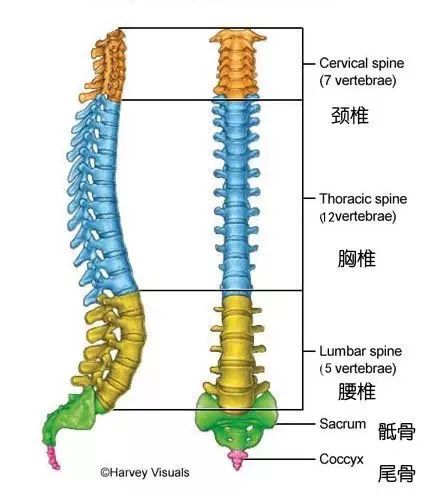When practicing yoga, careful Yoga people will find that in every Yoga course, the yoga teacher will take us to practice, there will be exercises involving flexible spine.

Before doing all yoga movements, you must also maintain the correct alignment and extension of the spine, and then carry out in-depth practice.

The spine must be straight? When practicing yoga, the spine must be straight.

Arching the back must be wrong?! Seeing this question, I think the answer given to me by experienced Jia people should not necessarily vary from person to person, or from practice to practice.

Anatomical structure of the spine before answering this question, I’d like to share with you the basic anatomical structure of the spine.

The spine includes cervical spine, thoracic spine, lumbar spine, sacrum and coccyx.

The motion angles of each link are as follows: therefore, according to the anatomical structure of the spine, we know that the whole spine can not only flexion / extension, but also lateral flexion and rotation (torsion).

In yoga, it is often referred to as “arching the back”, It often refers to the state of spinal flexion.

Arch back is not necessarily wrong.

In fact, in most yoga exercises, in order to avoid excessive lumbar pressure injury, the state of the spine should be in a straight line as far as possible to avoid excessive arch back, which is right.

But this does not mean that all the exercises in yoga, as long as the arch back, must be wrong.

Except for these three common situations, 01# the purpose of the practitioner is to practice the flexion of the spine, such as the cat pose in yoga and the spinestretch in pilates.

They all require to arch the back as much as possible and present the spine in a large “C” shape.

02.

Forward bending practice in Yin Yoga.

In the practice of yin yoga, great emphasis is placed on the deep relaxation of the spine, so as to achieve the purpose of relaxing the central nervous system.
Therefore, most yin yoga postures, such as Caterpillar, butterfly, hanging, dragonfly and so on, seem to be in the state of “arching back”.
In fact, they are to completely relax the spine.
03.
Repair exercise after a large number of back bending exercises after a large number of back bending exercises, many Jiaren will do one or more forward bending “arch back” spine flexion exercises.
It is used to neutralize or avoid the pressure on the spine caused by backward bending exercises, so as to maintain the overall balance of the spine.
Therefore, when practicing yoga, the flexion of the spine is also a practice method of flexible spine.
People must be flexible and not one size fits all.
Next, the yogi compiled a set of Yoga twisting postures with flexible spine, which can be explained with high-definition graphics.
The yoga teacher can be used in the member class, and the practitioners can practice directly.
It should be collected well! Standing forward flexion + torsion starting from the standing posture, the feet are separated from the hips, the body is folded down from the hips, the right knee is bent, the left hand drives the chest to the left, the right hand is supported on the brick, the back is extended to maintain 8 breathing heads to the knee + torsion sitting, the legs are straightened forward, the toes are hooked back, the right knee is bent, the right heel is close to the perineum to inhale, the arms drive the body to extend upward and exhale, the body is twisted to the right, and the left hand is placed on the outside of the thighs, Extend the right hand upward, keep 8 breaths, change the opposite side sitting position, twist the spine, sit and stand, straighten the legs forward, hook the toes back and bend the left knee, cross the left leg on the outside of the right knee, inhale, extend the body upward with both arms, twist the body to the left, support the left hand on the ground, deepen the torsion with the right hand against the left knee, extend the spine upward, keep 8 breaths, change the side balawaga sitting position, bend both knees, put both feet on the outside of the right hip, and overlap the right ankle with the left foot, Turn your left arm to the right side of the floor, turn your left arm to the right side, bend your arms to the right side of the floor, and keep your left arm on the right side of the floor.
In the exhalation position, turn your left arm to the right side, turn your left arm to the right side, and keep your right leg on your back, Extend the left arm forward and keep 8 breaths.
Change the side magic Chair + twist the standing position, put your feet together, touch your big toes, hold your hips with your hands, put your hips back and down, put your weight on your heels, put your hands together in front of your chest, inhale, lengthen your spine, exhale, turn your body to the left, turn your right arm against your left thigh, let your body twist more and keep 8 breaths.
Start with the opposite side crescent + twist the standing position, take a big step back from your right leg, and land on the back of your right leg, instep and knee, Right behind the toe, the left leg knee is right above the ankle, put your hands together, inhale to lengthen the spine, exhale to the left, keep 8 breaths, and change the opposite side.
Disclaimer: the content and pictures of this article are collected from the Internet, and the copyright belongs to the creator.
Please contact us in time if there is infringement!..

